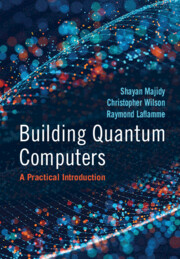Refine search
Actions for selected content:
48569 results in Computer Science
Spiralling Out of a Shell: Fictioning more-than-machine listening
-
- Journal:
- Organised Sound / Volume 29 / Issue 3 / December 2024
- Published online by Cambridge University Press:
- 17 December 2024, pp. 262-274
- Print publication:
- December 2024
-
- Article
- Export citation
RSL volume 17 issue 4 Cover and Back matter
-
- Journal:
- The Review of Symbolic Logic / Volume 17 / Issue 4 / December 2024
- Published online by Cambridge University Press:
- 02 January 2025, pp. b1-b5
- Print publication:
- December 2024
-
- Article
-
- You have access
- Export citation
OSO volume 29 issue 3 Cover and Back matter
-
- Journal:
- Organised Sound / Volume 29 / Issue 3 / December 2024
- Published online by Cambridge University Press:
- 31 January 2025, pp. b1-b2
- Print publication:
- December 2024
-
- Article
-
- You have access
- Export citation
Hello! I’ve Been Here the Whole Time: When non-cochlear sound art meets disability aesthetics
-
- Journal:
- Organised Sound / Volume 29 / Issue 3 / December 2024
- Published online by Cambridge University Press:
- 17 December 2024, pp. 285-291
- Print publication:
- December 2024
-
- Article
-
- You have access
- Open access
- HTML
- Export citation
RSL volume 17 issue 4 Cover and Front matter
-
- Journal:
- The Review of Symbolic Logic / Volume 17 / Issue 4 / December 2024
- Published online by Cambridge University Press:
- 02 January 2025, pp. f1-f4
- Print publication:
- December 2024
-
- Article
-
- You have access
- Export citation
Biomimicry in Electroacoustic Composition: Conceptual frameworks and prototypes
-
- Journal:
- Organised Sound / Volume 29 / Issue 3 / December 2024
- Published online by Cambridge University Press:
- 16 December 2024, pp. 254-261
- Print publication:
- December 2024
-
- Article
-
- You have access
- Open access
- HTML
- Export citation

Building Quantum Computers
- A Practical Introduction
-
- Published online:
- 29 November 2024
- Print publication:
- 11 July 2024
-
- Textbook
- Export citation
Usage-centered, efficient, and sustainable: an IoT-driven transformation of water heaters
- Part of
-
- Journal:
- Data-Centric Engineering / Volume 5 / 2024
- Published online by Cambridge University Press:
- 29 November 2024, e36
-
- Article
-
- You have access
- Open access
- HTML
- Export citation
Plingo: A System for Probabilistic Reasoning in Answer Set Programming
-
- Journal:
- Theory and Practice of Logic Programming / Volume 25 / Issue 2 / March 2025
- Published online by Cambridge University Press:
- 29 November 2024, pp. 134-167
-
- Article
-
- You have access
- Open access
- HTML
- Export citation
Handling shift and irregularities in data through sequential ellipsoidal partitioning
-
- Journal:
- Data-Centric Engineering / Volume 5 / 2024
- Published online by Cambridge University Press:
- 29 November 2024, e37
-
- Article
-
- You have access
- Open access
- HTML
- Export citation
3 - Abstraction
- from Part 1 - An Overview
-
- Book:
- Programming in Ada 2022
- Published online:
- 21 November 2024
- Print publication:
- 28 November 2024, pp 27-46
-
- Chapter
- Export citation
26 - The Specialized Annexes
- from Part 4 - Completing the Story
-
- Book:
- Programming in Ada 2022
- Published online:
- 21 November 2024
- Print publication:
- 28 November 2024, pp 843-860
-
- Chapter
- Export citation
18 - Parameterized Types
- from Part 3 - The Big Picture
-
- Book:
- Programming in Ada 2022
- Published online:
- 21 November 2024
- Print publication:
- 28 November 2024, pp 449-478
-
- Chapter
- Export citation
5 - In-Memory Data Processing in Large Data Centers
-
- Book:
- Data Management
- Published online:
- 21 November 2024
- Print publication:
- 28 November 2024, pp 109-121
-
- Chapter
- Export citation
Contents
-
- Book:
- Data Management
- Published online:
- 21 November 2024
- Print publication:
- 28 November 2024, pp vii-x
-
- Chapter
- Export citation
23 - Predefined Library
- from Part 4 - Completing the Story
-
- Book:
- Programming in Ada 2022
- Published online:
- 21 November 2024
- Print publication:
- 28 November 2024, pp 651-726
-
- Chapter
- Export citation
Answers to Exercises
-
- Book:
- Programming in Ada 2022
- Published online:
- 21 November 2024
- Print publication:
- 28 November 2024, pp 913-916
-
- Chapter
- Export citation
Index
-
- Book:
- Data Management
- Published online:
- 21 November 2024
- Print publication:
- 28 November 2024, pp 279-284
-
- Chapter
- Export citation
7 - GPU for Structured Data
-
- Book:
- Data Management
- Published online:
- 21 November 2024
- Print publication:
- 28 November 2024, pp 167-202
-
- Chapter
- Export citation




